How To Make A Camera Take A Picture Every 2 Seconds
Time-lapse photography is, by its very nature, a time consuming endeavour. It typically involves taking and processing hundreds of images. Information technology actually pays to plan your shoot and fourth dimension-lapse settings appropriately.
I wouldn't say there are whatever 'best' fourth dimension-lapse photography settings. These can vary depending on the camera and the subject field – just like conventional photography. In that location are, nonetheless, some full general principles regarding time-lapse settings.
Let'southward start past considering the upshot of timing and and so talk about exposure settings.

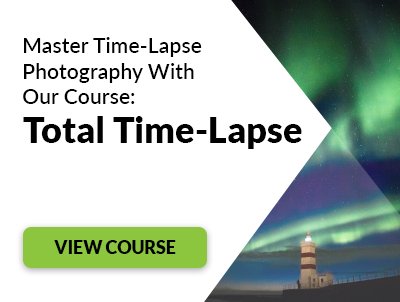
Time Lapse Frame Rate
A video is just a sequence of still images shown in quick succession. If we view the sequence at a too deadening speed, the result will exhibit an annoying flicker.
Speed the sequence upwards sufficiently and an upshot called the phi miracle will generate the illusion of a shine fluid move. This happens at around 12 frames per seconds.
Every bit a reference, most gimmicky films are shot at 24 fps, which nearly people agree looks natural.
You don't have to worry too much most the frame charge per unit when you're shooting your time lapse sequence. This is decided afterward on when all the images are combined into the final video.
Yous will, however, need to consider how fast the action is taking place. Otherwise, yous'll finish up with a serial of stills as shown here:

In the past, different frame rates and TV standards made it difficult to share videos and view them on unlike devices. Today, with digital Goggle box, we can view just almost any video on our estimator. The most common frame rates are 24 fps, 25 fps and 30 fps.
Allow'southward assume our time lapse video will be viewed at 25 fps. This means we need to accept 25 photos for each second of our final time lapse video.
If yous're just commencement to experiment with fourth dimension lapse photography, don't effort to make an epic feature moving-picture show. Instead, aim for something more than achievable – lasting say thirty seconds.
If nosotros desire to brand a 30 second long production we volition need 30 seconds ten 25 fps = 750 photos. Ideally, we'd like to capture all these images on a single memory card.
Memory Card Capacity
Y'all can shoot JPEG images if you want to fit as many images every bit possible onto a given media card. I would, yet, recommend that you shoot raw for maximum post-production flexibility.
Cheque the file size of a single raw photo for your chosen camera. Brand sure y'all have room for 750 such images on your memory card.
For case, on a Canon 5D Mk III the raw file size is around 30MB. Multiplying 30MB by 750 gives 22,500MB or 22.v GB. A 32GB memory carte du jour volition easily handle this many raw images.
Once you've set your camera's prototype size and quality settings, the number of remaining shots should be visible on your camera's LCD.
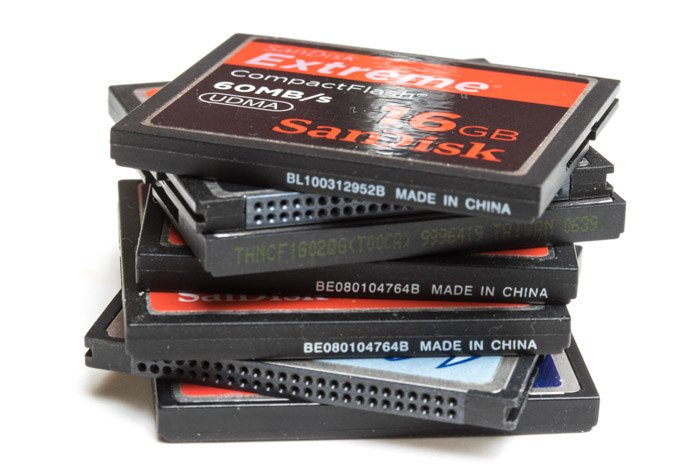
If you don't have a loftier capacity retentiveness card, you can just keep an centre on the remaining exposures. Swap in a new smaller chapters card each time you run out.
For time lapse, a high capacity card doesn't have to be of the expensive high speed variety. It'southward the chapters that counts – not the write speed.
Time-Lapse Interval
So we want to produce a 30 second time-lapse video and nosotros want to take 750 split photos. Now, you have to make up one's mind on the length of the actual photo shoot. The length of the shoot depends on the bailiwick.
Filming a flower opening may take a twenty-four hour period or two. A major construction projection could involve months. Long fourth dimension lapse projects tin can get complicated. You volition need to consider how to keep the camera powered up for long periods and how to cope with changing light levels. And you'll need to adapt for images to be automatically transferred to a difficult bulldoze.
For these reasons, it's best to start with a relatively short term subject field that you lot can shoot for an 60 minutes or two. This could be something like boats on a river, a cityscape or just deject formations.
Computing the Shooting Interval
Permit's suppose nosotros wanted to picture 2 hours of activity of our chosen subject. The interval we need to program into our camera or external intervalometer is just ii hours (2 x 60 x 60 = 7200 seconds) divided by the number of shots in our sequence. We've determined this is going to be 750.
That gives us 7200 seconds divided by 750 images which equals 9.6 seconds. We can just round this upwards and go the camera to take one shot every 10 seconds until we have 750 photos on the menu.
If you don't want to practice the maths yourself, there are plenty of handy time lapse calculators you can download to your phone. Some are gratuitous and others, like the PhotoPills app, require a small payment.
The PhotoPills app is usually associated with planning dark-time photography. Information technology'southward really a Swiss Army knife for photographers that includes a time lapse calculator among its many useful tools.
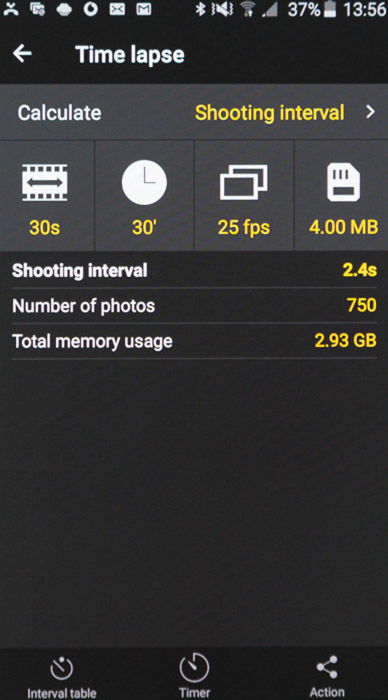
In this example, a finished time lapse of 30 seconds capturing thirty minutes of existent-time action to be viewed at 25 fps where each epitome is 4MB in size, gives a shooting interval of 2.iv seconds until 750 photos have been taken. All this will crave a memory card with a capacity of at least 2.93GB.
DSLR Time-Lapse Photography
DSLR cameras are not specifically designed for time-lapse photography. This presents some applied limitations when shooting images for a time -lapse video. In our case, the camera would be clicking abroad at one shot every ten seconds. This means that later on nosotros can compress two hours of shooting into xxx seconds of video.
This would produce a video that appears to run at 240 times the normal speed. It tin be somewhat manic and unnerving. If instead we wanted to capture the same time catamenia but go far announced to be just twenty times normal speed, our two hour session would have to replay in 7200 / 20 = 360 seconds.
This would crave 360 seconds 10 25fps = 9000 shots. In lodge to fit 9000 shots into a 2 hour shoot, nosotros would need to take one photograph every 0.8 seconds.
Few people want to and then casually add 9000 to their shutter count. And 9000 raw images at 30MB a pop would need 270GB of storage!
This is a worst-case scenario. If y'all were shooting JPEG images, each 1 is more likely to be only four or five MB. When multiplied by 9000, information technology is notwithstanding a considerable amount of disc infinite.
Using a DSLR to capture many high resolution images and combining them into a video in post certainly has its limitations. The large advantage of this method is that information technology can give extremely high quality results. This is because of the dynamic range and resolution it offers.
Resolution is a very important and central setting for time lapse. Let's consider this in a little more than item.
DSLR vs Video Resolution
Two of the most fundamental settings on any camera are the image size (resolution) and paradigm format (JPEG vs raw). Image resolution is related to the density of pixels on your camera'south sensor or on the display device. The higher the resolution, the more fine detail you lot can see.
Computer monitors, TVs and cameras have for years been following a relentless path toward ever greater resolution. However, there is no standardisation between the resolution of your flat screen Television set and that of your camera.
The boilerplate DSLR has a much higher resolution than a 4K UHD Goggle box (and a different aspect ratio). This ways that we don't always take to shoot at the total resolution afforded by our camera.
Hither's a scale comparison of some Telly screen resolutions and the resolution of a typical DSLR.
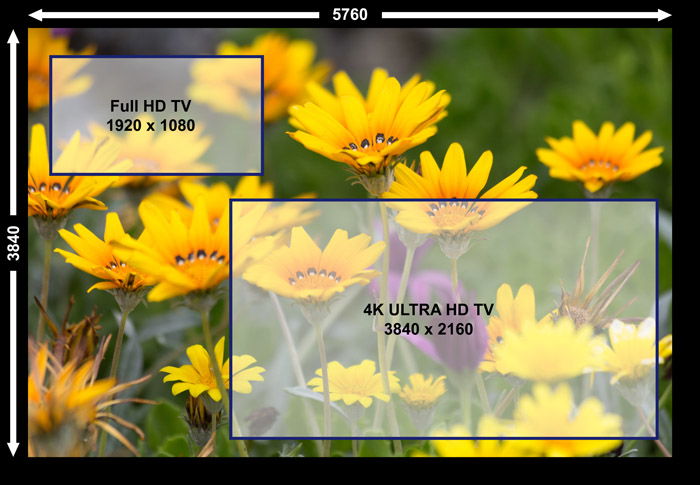
The background paradigm shows the size in pixels that you'd typically obtain from a modernistic DSLR. The overlays show the pixel dimensions for both full HD and 4K Ultra Hd video. Every bit you can see, the image from the camera is much larger than that actually needed to brandish on an Hard disk drive TV – fifty-fifty a so called '4K' Television set.
Clearly, some image size reduction and cropping volition be required. This will prepare your fourth dimension lapse images for their intended brandish.
When your images are all larger than needed for the video format you've chosen, you volition have the ability to introduce zoom and pan effects in post-production. This is known as the 'Ken Burns' effect. Information technology can add involvement to any video originally shot from a fixed perspective.
If you want to produce a video to show on a full Hd Television set (1920 ten 1080), notice that the paradigm from the camera is around ten times bigger than it really needs to exist. If you want to introduce some subtle zoom and pan furnishings, this is probably excessively large for that.
Remember that making videos from many hundreds of images places a significant workload on your estimator. Information technology likewise takes up a great deal of storage space. Processing images that are larger than they need to exist volition only make video production deadening and frustrating. One way to make the whole process more streamlined is to set up your photographic camera to piece of work at a lower resolution.
Bank check the 'Image Quality' settings on your camera. This is the screen that enables you to select the size and compression of the JPEG images your camera makes. For most cameras that shoot raw, you tin can likewise select the raw resolution.
In this example, I've selected a medium resolution raw setting:
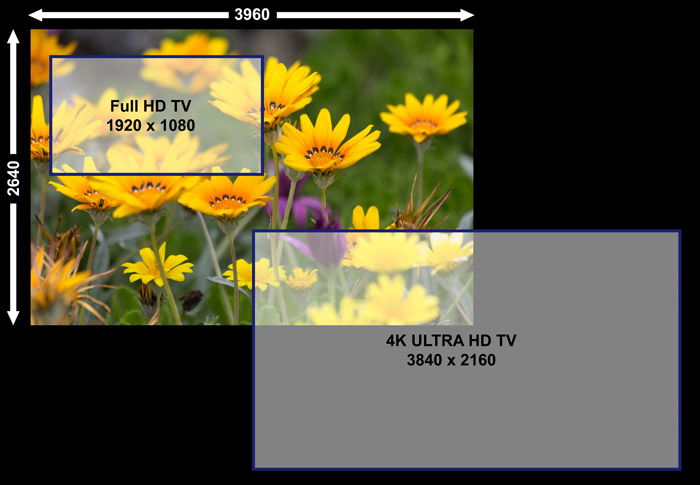
At this setting, the raw paradigm is all the same large plenty to more than than fill the screen on a 4K UHD Idiot box. Information technology tin can also supply enough of room for zooming and panning effects if you want to brand a video for a standard HD Telly. The file size it produces is half that of the full resolution setting.
You lot'll be able to store twice as many images on the same media menu. And your reckoner will process them more than easily while you retain the full dynamic range afforded by using raw files.
Raw vs JPEG
You should always aim to keep every bit much information in your images as you can during the workflow. This keeps your creative options open.
We've already seen that we don't always need to capture the full resolution a DSLR camera offers. What we do want is to maintain maximum power to suit shadows and highlights in each image. This is particularly important if the camera is photographing a loftier contrast scene or one where the lighting conditions change considerably during the shoot.
Raw files contain the maximum definition when recording the brightness in the scene (known equally dynamic range). They are also able to distinguish between many more brightness levels than a JPEG paradigm.
Your monitor (and indeed your eyes) cannot bear witness that full tonal range. But information technology does give your calculator a major reward when it comes to tonal adjustments without causing gaps in the prototype histogram that can otherwise lead to 'banding'.
Camera Settings for Individual Photos
Then far, we've considered only the central settings associated with the length and the resolution of your finished video. Since we're concentrating on making a time lapse video from a series of still photos, we now need to turn our attention to the settings needed for each individual photograph.
Again, at that place are no 'correct' time-lapse settings. These depend on the discipline and in this respect, information technology's no different to whatever still photograph.
However, as you'll exist taking hundreds of images, an important consideration is consistency from one image to the next. This helps to avoid flickering or other transient effects when nosotros view the sequence of images at the intended frame rate.
Unless you desire to photo a situation where the lighting level is going to alter significantly during the shoot, such as a dusk, you should aim to maintain a constant exposure value. This means selecting a shutter speed and discontinuity that works well for your called subject. And then using those same settings for all the other images in the shoot.
The only way to ensure values don't modify is to set your photographic camera to Manual Mode.

If y'all prepare your camera to a semi-automatic mode such equally discontinuity or shutter priority, the camera will calculate a new exposure value for each photo . This volition be based on whatever is happening in the scene at the time.
It can make a noticeable difference in exposure as subjects in your scene motion around. This is particularly relevant if your metering is gear up to spot or middle-weighted mode. Allowing the camera to change the discontinuity tin as well introduce unwanted depth-of-field changes.
Another setting that should generally remain fixed is focus. You certainly don't want the photographic camera to motorcar-focus on different parts of the scene as subjects move around from i frame to another.
I use back button focus (BBF). This mode I can set the focus once past pressing the AF button and know it won't change during the shoot. Unless yous've specifically set BBF on your camera, it will endeavor to auto focus when the shutter button is half-pressed or when the intervalometer triggers an exposure. To avoid this, switch your lens to manual focus mode.
What Shutter Speed Should I set up?
If you set up your camera to 'Movie Mode' to make a real-fourth dimension video directly in the camera, y'all would typically be shooting at a frame charge per unit of 25 fps. This ways that the effective shutter speed for each frame in the image cannot be slower than 1/25 2nd. The exposure wouldn't otherwise be consummate before the adjacent frame in the sequence needed to be shot.
There is, however, nothing to stop you lot from selecting a much faster exposure.
This range of exposure time is expanded all the more when y'all make your video from a series of unmarried photos. The effective shutter speed can approach the selected shooting interval.
For example, if you're taking i photograph every ten seconds, the shutter speed you select for each photograph could exist anything from eight seconds up to the fastest value your camera affords (calorie-free levels permitting). Note that you can't set the shutter speed to be exactly ten seconds in this instance. We take to give the shutter fourth dimension to close and open once more.
For subjects that are moving very slowly (such as a flower opening), the shutter speed is non that critical. The discipline is unlikely to be moving to whatsoever degree during the exposure. And the camera will almost certainly be on a tripod.
Permit's say you lot're shooting a nighttime-time movie of the stars. Your slowest shutter speed will be limited by the onset of star trails and the fastest shutter speed by the available light and lens aperture.
The situation is rather different when shooting cars at a busy interchange during the twenty-four hours. You might accept adamant that yous need to take 1 photograph of the interchange every v seconds and want to know the all-time shutter speed to apply.
Theoretically, your shutter speed could exist anything from say i/4000 sec to as tedious as iv seconds. What difference will this make to the final video?
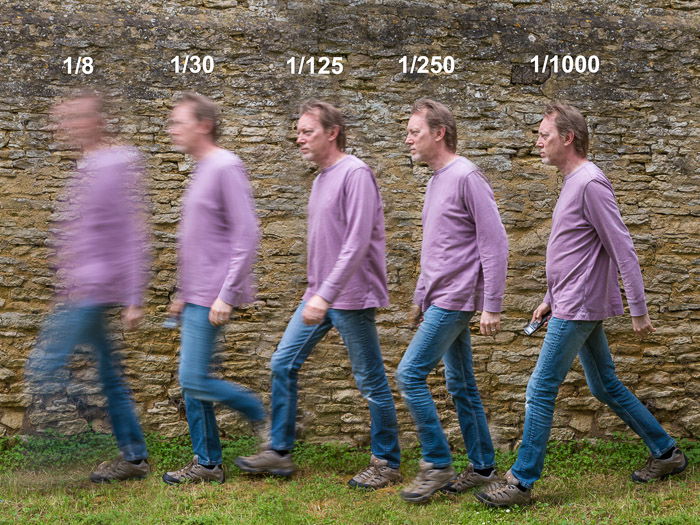
The answer is largely ane of creative interpretation. What impression are you trying to convey? If each exposure is relatively fast (say ane/k sec), then your video volition essentially comprise a series of still photos of cars. When viewed individually, they'll look like they're all stationary. Viewed in sequence, they volition appear to jump from one position to another in a very unnatural style.
If yous were really watching a video of a morning commute at 200 mph, you'd expect each frame to show at least some motion blur. For a more fluid fast motility issue, reduce the shutter speed to say 1/fifteen sec or even slower. Y'all can see the consequence of changing the shutter speed for a subject moving at the aforementioned rate in the header image.
Yous might find that you lot tin't achieve a deadening plenty shutter speed for the effect yous desire to achieve. This oftentimes happens when shooting in bright sunlight. If you do run into this problem, invest in a neutral density filter. This will cut down the light past several stops and let you lot to employ a slower shutter speed. Nosotros also have a great article on using a ND filter to remove people from long exposure shots which you can check hither.
If you're after some inspiration for fourth dimension-lapse photography subject area ideas, check out our tips on urban or adventure photography for a first! Nosotros also have a groovy tutorial on how to create a time-lapse with Photoshop.
Source: https://expertphotography.com/best-time-lapse-settings-photography/
Posted by: lincolnancestrand.blogspot.com

0 Response to "How To Make A Camera Take A Picture Every 2 Seconds"
Post a Comment